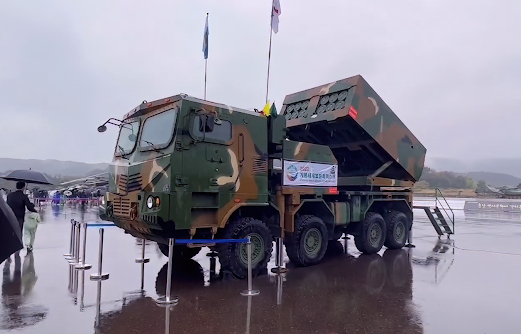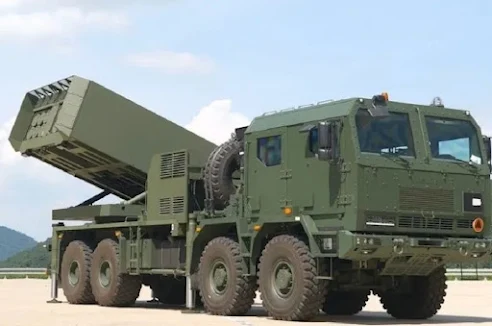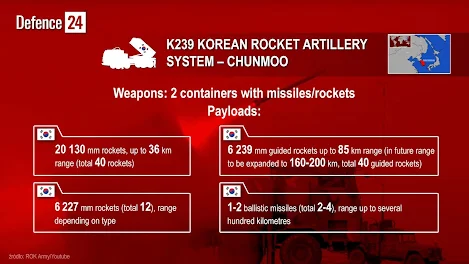As with the variety of military assets offered, here is an article featuring a potential weapons offer that came from what now counts as a traditional arms supplier of the Philippine Armed Forces, a sources country that has provided many military weaponry, from lead in fighter trainers (LIFT) to future capable corvettes (or frigates, given its capability).
INTRODUCTION
 |
| This platform is one of those considered by the Philippine Army for its firepower capability improvement. Image from Wikimedia Commons. |
The Philippine Army is now gearing up for getting newer Multiple-Launch Rocket Systems or MLRS, especially now that the country’s territorial defense counts as more essential than ever, aiming to augment anti-ship missile systems as part of the country’s coastal defense initiatives, alongside the acquisition of additional naval assets and fighter aircraft for both the Philippine Navy and Air Force, respectively. This comes as the government gears itself into pouring more investment into external defense posture.
The Department of National Defense and the Armed Forces of the Philippines are both striving for an aggressive, pre-emptive approach, with the one dealing more with deployment of key naval and air assets far from the mainland and implement the full measure of a full deterrence posture, while keeping the mainland from getting affected by any risks associated with a shooting war. This makes sure that opposition forces (OPFOR) will not pose a potent threat against the country’s national security and sovereignty.
Initially, the Philippine Army opted to get several K-136 Kooryong Multiple-Launch Rocket Systems or MLRS from South Korea through its reserve stocks, which was then the most awaited thing to see regarding the improving capabilities of the service branch during that time. This was until a report coming from the Department of National Defense no longer pursued the acquisition of the said artillery pieces from South Korea and instead opted to get better and modernized systems like the K-239 Chunmoo.
The decision to discontinue the acquisition of the K-136 Kooryong Multiple-Launch Rocket Systems (MLRS) is fully justified, as the Republic of Korea Army also has the K-239 Chunmoo MLRS as a replacement for the older platform and the rationale of getting a newer platform is an idealistic approach from the maintenance point of view, especially with more countries now getting the platform for their own use such as in Poland’s case of having bulk orders of the launchers.
Aside from the K-239 Chunmoo, the Philippine Army also seeks the M-142 HIMARS Multiple-Launch Rocket System for similar purposes, although its price tag may likely prompt the leadership to have it purchased in limited numbers and instead cover the remaining numbers with either the aforementioned South Korean made system or its competitor, the PULS (Lynx) Multiple-Launch Rocket System developed by Israeli defense firm Elbit Systems Ltd.
This shows that the Philippine Army still has the interest in securing its own Multiple-Launch Rocket System batteries, despite discontinuing the plans to get the older K-136 Kooryong MLRS from South Korean stocks and instead securing newly produced ones for its coastal defense and additional artillery firepower purposes. The interest comes alongside the land service branch’s renewed interest in securing BrahMos missiles after the Philippine Marine Corps secured their batteries, also for coastal defense.
In this topic, we discuss in-depth regarding the K-239 Chunmoo MLRS development with some background on South Korea’s defense industry, along with the specifications of the platform as compared to the HIMARS and the PULS MLRS of both Lockheed Martin and Elbit Systems Ltd., and also latest export developments of the K-239 Chunmoo that may help increase logistics chains and spare parts source, which in return, helps gauge the Philippine Army in its decision making in choosing this South Korean-made platform.
SYSTEMS DEVELOPMENT
 |
| The Polish K-239 Chunmoo, also known as the Homar-K MLRS, presents as an indicator of the system’s continuous development. Image Source. |
Like any other systems we discussed in this website, the systems that any of the branches within the Armed Forces of the Philippines may take along the way deserve its discussion regarding systems development, as it gives understanding and knowledge regarding the origins of any platforms presented and has the possibility for the military leadership to consider. For the K-239 Chunmoo, it started in 2009 when a contract for the replacement of the older K-136 Kooryong went to Hanwha Aerospace.
South Korea’s defense research agency DAPA or Defense Acquisition Program Administration has spent around US$112.8 million or KRW131.4 billion for the development and eventual production of the new multiple-launch rocket system for the Republic of Korea Army, of which the initial process for mass-produced copies started on August 2014 and since then effectively replacing the older K-136 Kooryong MLRS that the Philippine Army went into consideration before getting canceled.
The Republic of Korea Armed Forces have purchased at least more than a hundred K-239 Chunmoo MLRS to replace their older K-136 Kooryong MLRS, both intended for their active use within the South Korean Army and Marine Corps service, with 58 units initially ordered during the first production lines opened in 2014. Since then, the K-136 Kooryong MLRS served as one of South Korea’s mainstay artillery platforms as part of its defense, especially against North Korea’s constant threats.
The truck where the K-136 Kooryong MLRS has installed also comes as part of the development of the launcher and the rocket system munitions onboard, all of which are part of Hanwha’s development and eventual manufacturing process. The other variant comes with Poland’s Jelcz truck chassis, both of which have 8x8 wheels for better traction of the vehicles. We will discuss this further on the specifications part of this topic regarding the South Korean-made Multiple-Launch Rocket System.
With the Polish interest in acquiring the K-239 Chunmoo MLRS, or what they called as the “Homar-K” Multiple-Launch Rocket System, it may help advance further any future developments that Hanwha Aerospace may have with this system, which may eventually provide them with the much-needed marketing points once they further market the systems to the Philippine Army for its coastal artillery defense needs, going alongside the likes of the BrahMos coastal-based anti-ship missile system from India.
SPECIFICATIONS
 |
| The K-239 Chunmoo can operate with different missile payloads depending on mission requirements. Image Source. |
Understanding the specifications of the K-239 Chunmoo Multiple-Launch Rocket System or MLRS currently employed by the Republic of Korea Armed Forces is an important thing, as this will help measure and give comparative capabilities to other ones that may go as a potential future platform of the Philippine Army such as the M-142 HIMARS MLRS, and also in knowing more in its improvements as compared to its predecessor, the K-136 Kooryong Multiple-Launch Rocket System once offered to the land service branch.
First to check regarding the specifications of the K-239 Chunmoo MLRS is its dimensions, whereby it comes with a weight of at least twenty-five (25) tons, length of nine (9) meters, width of two point five (2.5) meters, and height of three (3) meters. To add it up, the K-239 Chunmoo comes with a diesel engine with a power of 400 horsepower (hp), enabling it to have a maximum road speed of 90 kilometers per hour (kph), while having an overall range of at least 800 kilometers.
To add it up, the K-239 Chunmoo has the capability of carrying and firing rockets of different rounds, just as it is with the M-142 HIMARS MLRS with both of its regular rocket rounds of six (6) canisters of either the ER-MLRS or the guided MLRS or abbreviated as the GMLRS munition, and a single round of MGM-140 ATACMS warhead for specific mission requirements. Multiple rocket load-out options enable both the M-142 HIMARS and the K-239 Chunmoo to perform with better results.
Speaking of the varying load-outs that the K-239 Chunmoo comes in its arsenal of rocket options, it usually comes with six (6) differently sized rocket rounds, although only three (3) of these rockets have specified performance depending on the number of rockets can load in a single MLRS unit, its weight, and its firing range. The three different rocket rounds with specified performance are the 130 mm rocket load-out, 227 mm rocket load-out, and the 230 mm rocket rounds.
The 130 mm rocket is one of the common rounds that is available in the South Korean military’s artillery arsenal, as this is also the one that the K-136 Kooryong MLRS uses as its regular rocket munition. This makes sense from the logistical point of view as the 130 mm rocket can launch from these two differing systems, although the K-239 Chunmoo has the advantage of firing larger rounds and heavier rocket load-out. This regular rocket comes with 55 kg rocket weight, 20 kg warhead weight, and a range of 23 kilometers.
While the 130mm rocket for a single K-239 Chunmoo MLRS unit comes with 40 tubes, these other rocket rounds are heavier and larger than this conventional munition, although it goes limited to only just 12 rounds, fitted in its respective canisters. This refers to both the 227 mm rocket rounds and the 230 mm rocket rounds, with the rocket weight coming at 296 kilograms and 300 kilograms, respectively. Likewise, both aforementioned munitions have a greater range of around 45 kilometers and 80 kilometers, respectively.
This means that the K-239 Chunmoo MLRS comes with more firepower packed with its rocket load-out as compared to the M-142 HIMARS Multiple-Launch Rocket System or MLRS, as the former loads twice the typical 227 mm rocket rounds than the latter, although its key disadvantage is it cannot get embarked onboard a C-130J aircraft given both its size and weight, the latter showing that the South Korean MLRS being twice as heavy as the US-made wheeled MLRS.
It shows a clear example of showing pros and cons of both platforms, with one capability gets traded to another to attain either the mobility that the M-142 HIMARS MLRS have, or the firepower that it can load on where the K-239 Chunmoo MLRS is clearly at the advantage.
IN SUMMARY
 |
| The Philippine Army is also considering the Elbit Lynx PULS for its MLRS Acquisition. Image from Elbit Systems Ltd. |
The Philippine Army, like the other service branches under the Armed Forces of the Philippines, is now gearing up for territorial defense purposes, as the current administration aims to get it as a priority amidst ever-uncertain situation across the globe, especially with the ever-increasing aggression in the West Philippine Sea by external actors like China, and also its long-looming invasion of the island nation of Taiwan, which only sits lie north of the country.
As the other branches like the Philippine Navy and the Philippine Air Force purchasing their respective military hardware like guided-missile frigates and multi-role fighter Jets, respectively, the Philippine Army is gearing up for coastal defense deployments, other acquisition plans like additional armored vehicles are getting set aside in favor of securing more military hardware specialized on external defense such as Land-Based Missile Systems and multiple-launch rocket systems or MLRS.
Speaking of MLRS platforms, the Philippine military is clearly interested in securing the likes of the M-142 HIMARS for its use, although the likes of K-239 Chunmoo MLRS and the Elbit Lynx PULS (see image above) are also in the table. This modern South Korean MLRS is now pushed on as the Philippine Armed Forces no longer see interest in securing the older stocks of K-136 Kooryong Multiple-Launch Rocket Systems from South Korea and instead focused more on modern MLRS solutions with flexible munition options available.
This also means that putting the K-239 Chunmoo into consideration as a preferable Multiple-Launch Rocket System of the Philippine Army may get its viability later on, especially that the South Koreans successfully exported a bulk of this system to the eastern European country of Poland, enabling them to market this into other members of the North Atlantic Treaty Organization or NATO, of which Poland is a member of, as this improves logistical capabilities later on for outsourcing spare parts and munitions.
In an ending note, the Philippine Army is keen on securing more MLRS solutions into its own tools that help secure the country from external threats with its shore-based deployment of missile and artillery platforms, although it remains to see which platforms get the best preference for the leadership or if the acquisition program pushes through given that there is always a change of plans. But one can still look forward to the Philippine Army’s plan in securing its MLRS, whether it may be the K-239 Chunmoo or not.













No comments:
Post a Comment